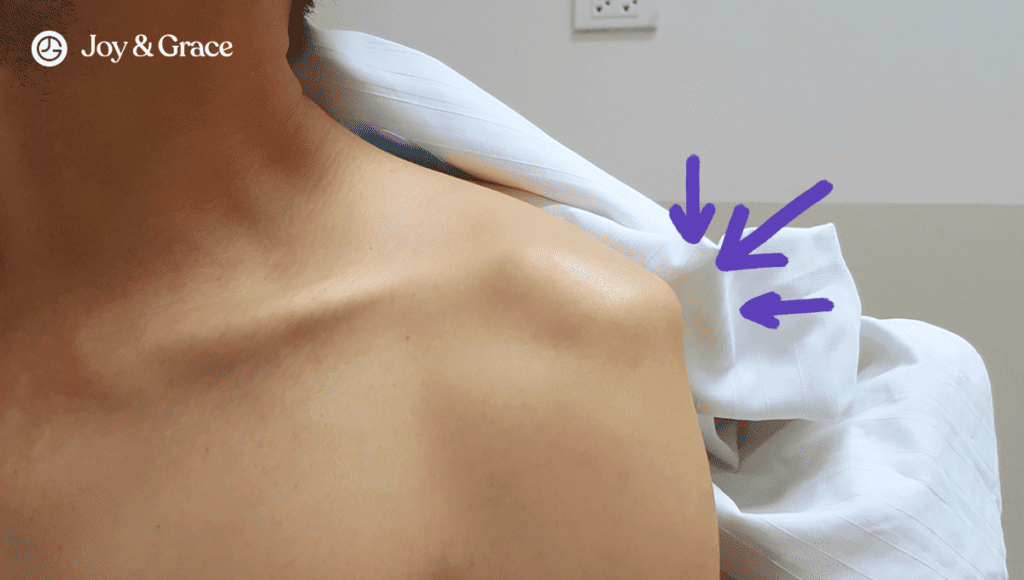The shoulder joint is the most flexible joint in our body. It represents the connection between the shoulder blade and the upper arm bone. The flexibility of the shoulder joint is a real blessing because it lets us move our arms freely.
Sometimes, though, it may be a curse. Why so? Well, the shoulder is the joint that’s most often dislocated or displaced. Shoulder dislocation can cause lots of pain and distress. It usually requires attention right away. So, what are the causes and symptoms of a dislocation? How can you diagnose it and relieve your shoulder pain?
What’s a Dislocation of the Shoulder?
The shoulder joint is known as the glenohumeral joint. It’s a ball-and-socket joint connecting the upper arm bone (humerus) and the shoulder blade.
A shoulder dislocation occurs when the upper arm bone gets out of the joint socket.
This separation and its associated damage can cause excruciating levels of pain. Bone detachment may affect surrounding nerves, vessels, and muscles. The ligaments, muscle tendons, and cartilage that support the joint may also suffer. As a result, pain signals fire from all fronts at once.
If a severe injury caused the dislocation, the damage might also involve regions other than the shoulder. These are strong reasons why shoulder dislocations need immediate medical care.
Shoulder dislocations can be of three types, depending on which direction the humerus dislocates:
- Anteriorly (forward)
This type accounts for 97% of all dislocations.
- Posteriorly (backward)
- Inferiorly (downward)
What Causes a Shoulder Dislocation?
A shoulder dislocation most commonly occurs with a powerful force acting on the shoulder joint.
In this sense, injuries are the culprits in 95% of shoulder dislocation cases. By injuries, we mean any of the following:
- Sports-related shoulder injuries
Sports that involve contact are particularly associated with shoulder displacement. Football, soccer, hockey, and wrestling involve forceful pushing and pulling. Other sports that risk falling (like skiing or gymnastics) can also be associated with shoulder dislocation and pain.
- Falls unrelated to sports activities
Athletes aren’t the only ones who may suffer from dislocated shoulder pain. Accidents, such as falls on an outstretched arm, can happen to anyone on a day-to-day basis. They may also lead to shoulder dislocations. Other examples of common injuries include direct blows or twists on the shoulder.
- Traumatic injuries from traffic accidents
Motor accidents are unpredictable. They can harm any part of the body. We usually hold the steering wheel with outstretched arms and hands when driving. You can probably imagine how devastating forceful contact can be in this case. It may dislocate and seriously damage the shoulder joint.
- Overuse and wear-and-tear injuries
The shoulder joint and its ligaments can become weaker with time and usage. Repetitive, strenuous movements at the shoulder joint can damage it. Over time, damage may build up and lead to dislocation.
5% of dislocations may arise from defects at birth or so-called lax (weak) ligaments.
Dislocated Shoulder Risk Factors: Who’s at Risk?
A shoulder dislocation can happen to just about anyone. But some people may be more at risk than others. Increased odds of developing shoulder dislocation may be associated with:
- Repetitive movements
Repeated strenuous movements at the shoulder joint may damage the joint. Joint damage may cause weakening of the shoulder joint structures. Consequently, dislocations may occur.
- Certain occupations
As mentioned, certain athletes have a higher risk of experiencing shoulder dislocations. Other groups at risk may include construction workers, painters, and motorcyclists.
- Previous dislocations
A previous shoulder dislocation makes you more likely to get another one.
- Age
An increased age means your ligaments, tendons, and bones become weaker. They become more vulnerable and much less able to withstand movements at the joint. This makes dislocations more likely.
The most common age range for men with a displaced shoulder is 20-30 years. Women tend to suffer from dislocations at a later age (61-80). The later peak in women is attributed to increased falls in an aging population.
Interestingly, recurrent dislocations are more common in people under 40. About 50% of people aged 15-30 who have had a shoulder dislocation suffer from repeated episodes.
- Being male
Studies show that men have a higher chance of having repeated shoulder dislocations than women. This gender difference is likely due to the fact that men are more aggressively involved in contact sports.
- Genetics
According to a 2017 study, certain genetic makeups can increase the risk of shoulder dislocation by 69%.
What Does a Dislocated Shoulder Feel Like?
A dislocated or separated shoulder often calls for urgent care. Seek medical care right away if you experience any of the following symptoms:
- A “popping” or “rolling out” feeling at the shoulder joint
- Intense and persistent shoulder pain that gets worse with movement
- Swelling or bruising of the shoulder
- A deformed or out-of-place shoulder appearance
- Inability or difficulty moving your arm
- Numbness and tingling in the shoulder region, which spreads to the arm
Can I Get Nerve Damage From a Dislocated Shoulder?
The shoulder joint is a region where lots of nerves happen to pass by. Thus, a change in the environment, such as a shoulder dislocation, may indeed cause nerve damage and pain. When the shoulder gets displaced, the surrounding nerves may get stretched, irritated, and injured.
Nerve injury may be of various degrees, as follows:
- Mild nerve injury (known as neuropraxia)
- Moderate injury (known as axonotmesis)
- Complete nerve disruption (known as neurotmesis)
Complete disruption (un)luckily accounts for only about 3% of nerve injuries from a displaced shoulder.
How Do I Know if I Have Nerve Damage in My Shoulder?
Aside from shoulder pain, damage to the nerves around the shoulder may lead to upper limb symptoms and disabilities, including:
- Temporary weakness
- Numbness
- Tingling sensations
- Permanent paralysis (which can lead to chronic pain, deformities, and psychological distress)
What’s the Most Common Nerve Injury After a Shoulder Dislocation?
Which nerve is in the most danger when the shoulder is dislocated? Well, shoulder dislocation most commonly injures the axillary nerve.
In fact, studies found that the axillary nerve is involved in all cases of shoulder dislocation associated with neurological symptoms. The axillary nerve supplies the skin and muscles of the shoulder region.
In addition to affecting a single nerve, a displaced shoulder can also affect a whole bundle of nerves. By bundle of nerves, we mean the brachial plexus, a network that passes from the base of the neck to the shoulder.
The brachial plexus contains many nerves, including the axillary nerve we mentioned. These nerves branch from the plexus to supply the shoulder, arm, hand, and fingers.
How Long Does Shoulder Nerve Pain Last?
The time it takes for nerve damage to heal depends on the degree of the damage itself.
- Mild nerve damage and its associated pain can take 2-3 months to go away.
- Pain from moderate nerve damage that affects the contents of the nerve fibers can last longer. It may take months or years to heal fully.
- More severe nerve damage may require surgery within six months of the injury.
Can a Dislocated Shoulder Cause Bicep Pain?
Yes, a dislocated shoulder can cause bicep pain.
As mentioned, a displaced shoulder is associated with the separation of the bones that make up the shoulder joint. A dislocated shoulder causes instability within the joint. This shoulder instability may also affect the long tendon of the bicep muscle. This tendon attaches to the rim (labrum) of the joint.
As a result, the tendon of the biceps muscle may become inflamed, leading to a condition called tendonitis. Bicep tendonitis is characterized by:
- Pain or tenderness in the front of the shoulder, which spreads to the bicep area
- Pain that worsens with overhead activities or heavy lifting
- An occasional snapping sound or sensation in the shoulder
Can a Dislocated Shoulder Cause Neck Pain?
Yes, a dislocated shoulder may also indirectly cause neck and back pain. Here are some ways how:
- The cause of the dislocation (such as an injury) may affect not only the shoulder but also other nearby regions. For instance, a bicycle crash that results in a dislocated shoulder can also lead to neck and back pain due to the force of impact during the accident.
- Additionally, a nerve injury can have a domino effect. The pain can spread to fibers in the neck and back.
- Your body may also try to compensate for shoulder weakness. It may change the way you move and maintain your posture, causing strain and tension in your neck and back.
How is a Shoulder Dislocation Diagnosed?
The diagnosis of shoulder dislocation begins with a quick history-taking and physical exam. During a physical exam, your doctor tests the movement and function of your shoulder. They may also perform a neurologic examination (testing if the nerves are working properly).
Take note that this typical history-taking and physical exam process is usually done only in non-urgent cases. If you’re dealing with a shoulder dislocation that can’t wait, your doctor will typically try first to manage your pain. Then, they can order imaging studies, such as an X-ray or MRI (Magnetic Resonance Imaging).
How is a Shoulder Dislocation Treated?
The first step toward adequate shoulder dislocation pain treatment is pinpointing the diagnosis. Working out if the shoulder was dislocated forward, backward, or downward is essential.
Your doctor may then decide to perform a technique that puts your shoulder joint back into place. This technique is called a closed reduction. Afterward, your shoulder may need to be immobilized for 1-3 weeks. This means you’ll have your shoulder wrapped and put in a sling that limits movement. While using the sling, ensure to gently move your elbow, wrist, and hand from time to time.
You may continue with physical therapy after the third week of immobilization. Physical therapy strengthens the shoulder muscles and improves the joint’s range of motion. Making muscles stronger can provide “a supportive brace” for the shoulder joint.
Your doctor may advise you to perform light exercises for 4-6 weeks. These exercises may include:
- Active and passive flexion
- Extension
- Abduction (moving the arm away from the body)
- Inner and outer rotation
After starting with strengthening exercises, you may take up swimming. Swimming is considered an ideal exercise to build up your strength further. It’s recommended not to return to vigorous training until three months after the injury.
If your shoulder dislocation is severe and involves torn ligaments and tendons, surgery may become a must. We discuss the surgery options below.
How Do I Fix Dislocated Shoulder Pain at Home?
It’s crucial to understand that you should not neglect a shoulder dislocation. You never know how severe the joint damage might’ve been. Address your complaints to get the proper diagnosis and treatment. Make sure you’re always following your doctor’s advice.
Once your doctor has checked your shoulder, they may suggest that you manage your pain at home with:
- Rest
Avoid any physical activity that may cause more damage to the shoulder.
- Ice therapy
Ice may help fight pain and reduce swelling in the first 2-3 days after an injury. During the first two days, apply an ice pack to the shoulder three times a day. Keep it on the painful, swollen shoulder for 15-20 minutes at a time. If the swelling hasn’t gone down, continue for an extra 1-2 days.
- Pain medications such as Tylenol (paracetamol) or Advil (Ibuprofen) can help ease pain and reduce inflammation after an injury. Always use them as directed.
Closed Reduction
As we mentioned, closed reduction is a technique your doctor can use to correct a shoulder dislocation.
Your doctor can opt for any of the numerous reduction techniques. These are often named after the people who discovered them (Hippocratic, Stimson, Milch, etc.). First off, you’ll be lying down on your back. You may be given an intra-articular injection or a regional anesthetic that numbs the pain. In rarer cases, general anesthesia (putting you to sleep) may apply. Your doctor decides on the technique based on the type of dislocation.
It takes about 30 minutes to perform. You may usually return home an hour after the procedure.
When Does a Dislocated Shoulder Require Surgery?
Shoulder dislocation surgery is typically the last resort to repair the damage caused by a shoulder dislocation.
Surgery intends to restore function and strength and reduce shoulder pain. In addition to these goals, orthopedic surgeons may also address:
- Torn ligaments
- Torn tendons
- Broken bones from the injury
Here are the most commonly performed surgeries for shoulder dislocations:
- Advanced arthroscopic techniques
Orthopedic surgeons often prefer arthroscopic techniques to repair soft tissues and fractures. And not without reason, either!
Arthroscopy techniques are becoming increasingly popular and preferred as they’re minimally invasive. This means they involve only small skin incisions. Arthoscopy uses a thin tube (called an arthroscope) with a tiny camera at its end. Doctors make an incision in the shoulder region and insert the arthroscope. The tube allows them to see inside and make the necessary repairs.
- Open surgical repair
Open surgical repair is a more traditional technique. It involves making an incision that typically results in slower recovery times than arthroscopic techniques. The open repair reduces recurrent shoulder dislocations by up to 95%. It remains the standard against which other shoulder surgeries are measured.
- Ligament and tendon reconstruction and repair
Ligament and tendon repair in shoulder dislocation surgery is also vital. As discussed previously, when the shoulder dislocates, it can harm these support structures. As a result, the joint might weaken. Surgeons use advanced arthroscopic techniques to rebuild them. This ensures shoulder stability and strength and prevents future dislocations.
- Bone transfer and grafting
Bone graft surgery is considered when a shoulder dislocation happens again after surgery. Recurrent dislocations can warn doctors that the shoulder isn’t stable enough. Without grafting, dislocations could happen again and again.
In bone graft surgery, a piece of bone from elsewhere in the shoulder or body may need to be transferred to the shoulder joint. This transferred piece is called a replacement or graft. Orthopedic surgeons may use arthroscopic surgery to repair the damage while attaching the grafts.
Complications
Arthroscopic techniques make sure your recovery is quicker and less painful. However, complications may still occur. They’re rare and may include:
- Recurrent dislocations
- Persistent pain
- Loss or restriction of mobility
- Infections
- Failure of the graft to stay in place
- Injury to the surrounding nerves and vessels
- Degeneration of the joint cartilage
How Long Should My Shoulder Hurt After Dislocation?
Dislocated shoulder pain may continue for as long as you don’t treat it. While painkillers may temporarily ease the pain, they’re not long-lasting solutions. This is why we stress the importance of consulting your doctor.
Orthopedic specialists are the most qualified medical professionals to deal with shoulder dislocations. If in doubt, you may also reach your PCP (primary care physician), who may refer you to an orthopedist.
Does a Dislocated Shoulder Ever Fully Heal?
Dislocation-related shoulder pain doesn’t normally go away by itself. A quick treatment is vital.
The severe pain associated with dislocations goes away almost instantly once the joint is back in place. Any pain you may feel after the reduction technique can be managed with medications and ice.
Recovery: For How Long Am I Injured With a Dislocated Shoulder?
It usually takes 12 weeks to recover from a dislocated shoulder. It may take up to 16 weeks to fully return to sports, though.
Your doctor may use the following criteria to decide when you can return to playing sports and performing intense exercise:
- Your shoulder and shoulder blade reach a full range of motion.
- The shoulder joint shows normal movement rhythm.
- You demonstrate a full active and passive range of shoulder motion.
- Your rotator cuff muscle strength is at 80% of the painless side.
- Your daily activities are pain-free.
If the damage is too severe, recovery may be more problematic and last longer. Proper recovery from a dislocated shoulder is only possible by following your doctor’s advice.
Can a Dislocated Shoulder Be Prevented?
So far, we’ve stressed the importance of proper treatment for a dislocated shoulder and its associated pain. But one measure is even better than medical treatment: prevention!
To prevent a first or recurrent dislocated shoulder, you must:
- Follow the treatment plan that your doctor devised
- Take extra care to avoid falls and sudden shoulder movements
- Protect yourself when playing sports and driving
- Exercise regularly to strengthen the tissues surrounding the shoulder joint
Takeaway
A shoulder dislocation occurs when the upper arm bone gets out of the joint socket. This separation and its associated damage can cause excruciating levels of pain.
Injuries are the culprits in 95% of shoulder dislocation cases. They may range from sports-related injuries to falls and traffic accidents.
A dislocated or separated shoulder often calls for urgent care. It’s typically characterized by a “popping” or “rolling out” feeling at the shoulder joint and intense pain with movement.
A shoulder dislocation may cause nerve damage and pain. It most commonly affects the axillary nerve.
Shoulder dislocation may cause bicep tendonitis and pain. It may also give rise to shoulder pain, which spreads to the neck and back.
The diagnosis of shoulder dislocation begins with a quick history-taking and physical exam. Imaging studies, such as an X-ray or MRI, may confirm the diagnosis.
Your health care provider may decide to perform a closed reduction to put your shoulder joint back into place.
If your shoulder dislocation is severe, surgery can become necessary.
Dislocated shoulder pain may continue for as long as you don’t treat it. The severe shoulder pain associated with dislocations goes away almost instantly once the joint is back in place.
It usually takes 12 weeks to recover from a dislocated shoulder.















